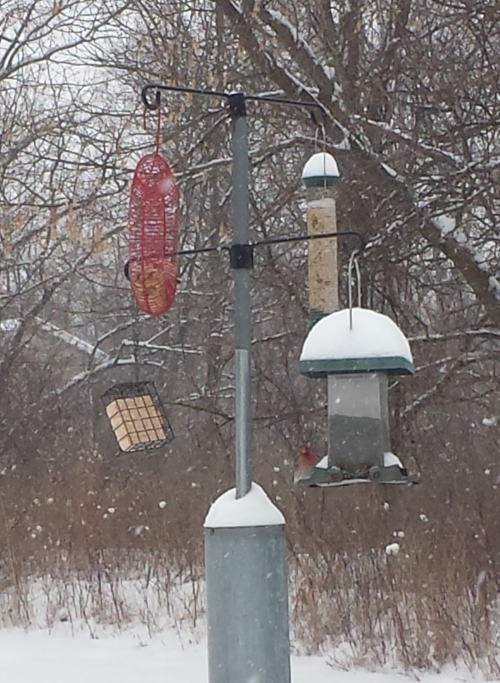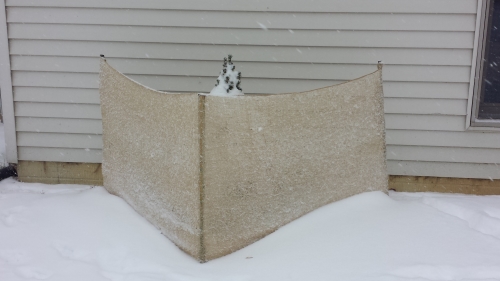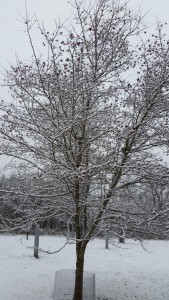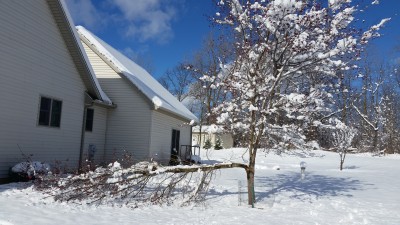December Gardening Advice for Manchester – 2015
by Jennifer Fairfield
Editor’s Note: Manchester resident, Jennifer Fairfield, owns and operates the Garden Mill in Chelsea, serves on the Manchester Community Garden Committee, and volunteers with the school gardens at Klager and the MECC.
Now that the snow is gone, and the temps are a little bit warmer, if you haven’t finished all the clean-up, get it done now, before we get another reminder that winter is on its way! Keep your hoses handy, though. As long as the ground isn’t frozen, you should keep watering your trees whenever we don’t get at least an inch of rain (or approximately 10 inches of snow!) each week. We had a very dry summer and early fall, and it’s not good for our trees to go into winter low on water.
Another thing to do for your evergreen trees and shrubs, before the ground freezes, is to put up wind screens to help keep them from drying out over the winter. When the ground is frozen, plants can’t take up water, but evergreens especially can lose what water they have when it’s windy. The burlap we sell at the store is my screen of choice, because it allows some air flow, but provides protection from the worst drying effects of the wind. Drive stakes into the ground, and then attach the burlap to the stakes, using cable ties or sturdy string. The burlap screen should at least be placed along the west and southwest sides of the plant, or even all around, depending on where your plants are placed and how much wind they tend to get. Leave the top open, so the plants can get sun.
With the type of winter that the weather gurus are calling for this year, mulch is going to be important to help your perennials, shrubs, and trees survive. The forecast seems to be that we will be warmer than the last two winters, and won’t get as much snow. That doesn’t mean that it won’t get cold or that we won’t get snow at all! My concern is that it will fluctuate, and that can cause issues like frost heave for our plants. Frost heave usually happens when the soil thaws and then freezes again, which can cause plants’ roots to “heave” out of the ground. Plants can have a hard time surviving this, so a good mulch cover can work to keep the soil frozen during the winter, helping to prevent damage. Add mulch to your flower beds, shrubs, and trees after the ground has frozen, to avoid keeping the ground warmer longer.
The wet snow we got was the type that can cause a lot of damage to trees and shrubs, as my poor Washington Hawthorn can attest (the picture to the right was taken just as the storm was getting started, while the picture at the top was taken the following day). Heavy snow can weigh down and potentially break branches, so promptly remove snow to help prevent damage. It’s easy to do more harm than good though, if you’re not careful. Use a broom, and gentle upward motions to sweep away the snow. Banging on frozen branches to shake off snow can break them. If we get ice, the best thing to do is nothing. Trying to remove ice from your trees can often cause more harm than good.
One good thing about the snow that we got is that, because the ground wasn’t frozen when it snowed, the snow acted like a blanket when the nighttime temperatures dropped into the teens immediately after. That kept the ground from freezing, and means that the procrastinators (like me!) can still plant bulbs. I just finally got my garlic planted this weekend. It’s the latest I’ve ever done that, but it was still so warm, and I didn’t want it to start growing yet, so was waiting for it to cool down (that’s one of my excuses, anyway!). I’m going to plant some more crocus this coming weekend, too. I just love how cheerful and optimistic crocus are in the spring! If you’re still thinking of planting any spring-blooming bulbs, we’ve got them on sale at the store! Bulbs can be planted all the way up until the ground is frozen.
My favorite thing to do when it’s snowing out is to watch the birds at my feeders. They are busily flying back-and-forth between the feeders and trees, and their colors show up so beautifully against the snow (especially the cardinals!) Keep your feeders full, so you can enjoy the show, and so that the birds don’t have to go searching for food, which is hard to find under snow.
Be sure to clean your feeders out frequently. Feeders can spread disease, so cleaning them out is important. One disease that affects some of the birds coming to our feeders is House Finch eye disease. It appears to spread easily from sick birds to other birds as they visit our feeders, and can be deadly to them. House Finches are the birds most often affected, but it has also been seen in Goldfinches and Purple Finches. The Cornell Lab of Ornithology has these recommendations for feeding:
Space your feeders widely to discourage crowding.
- Clean your feeders on a regular basis with a 10% bleach solution (1 part bleach and 9 parts water) and be sure to remove any build-ups of dirt around the food openings. Rinse well, and allow your feeders to dry completely before rehanging them.
- Rake the area underneath your feeder to remove droppings and old, moldy seed.
- If you see one or two diseased birds, take your feeder down and clean it with a 10% bleach solution. You may also want to remove feeders for a few days to encourage sick birds to disperse.
Read more about the disease at the Cornell website.
Clean out your birdhouses, and leave them out for the winter, as long as they aren’t susceptible to breaking in the cold. An empty birdhouse can provide birds a place to huddle together to keep warm at night.
Put out a heated birdbath, or put a de-icer in your existing birdbath, so that your birds have a source of fresh water all winter. Water is as essential as food, and becomes much harder to find in the winter.














You must be logged in to post a comment Login